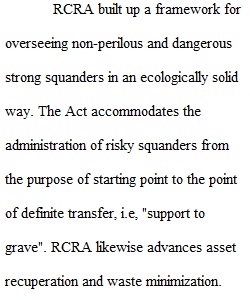


Q Read the Resource Conservation and Recovery Act and answer the following questions: What is the main purpose behind the enactment of the RCRA? What were Congress’ goals in drafting this and what was the main public policy/public good argument advanced? Read the below two links which discuss the most common RCRA violations. Consider why it is so important for corporations engaged in the generation, handling, transportation, storage, or treatment of hazardous waste to be familiar with RCRA and to have policies/procedures in place to ensure compliance. Also, because of the catastrophic damage that can result from a breach in safe transport of hazardous waste, heavy fines are imposed on those who violated the criminal proscriptions (“knowingly endangering”) of RCRA. The maximum penalty is a fine of $250,000 or imprisonment for up to 15 years. [United States v. Protex Indus., Inc., 874 F.2d 740 (10th Cir. 1989) involving a prosecution for violation of RCRA's "knowing endangerment" provision]. However, despite these hefty consequences, companies oftentimes make business judgment decisions weighing the cost of compliance with the risk of censure. From a strictly financial point of view, there may be times when it is cheaper to risk noncompliance than to comply. Discuss a time in your professional experience where you may have encountered a similar dilemma and also discuss what the ethical resolution should be. What is the main purpose behind the enactment of the RCRA? What were Congress’ goals in drafting this and what was the main public policy/public good argument advanced? Read the below two links which discuss the most common RCRA violations.
View Related Questions